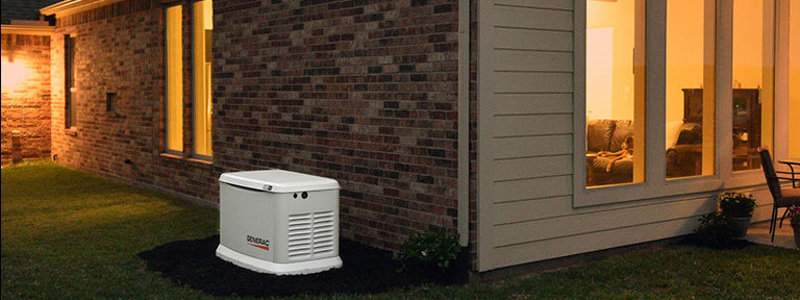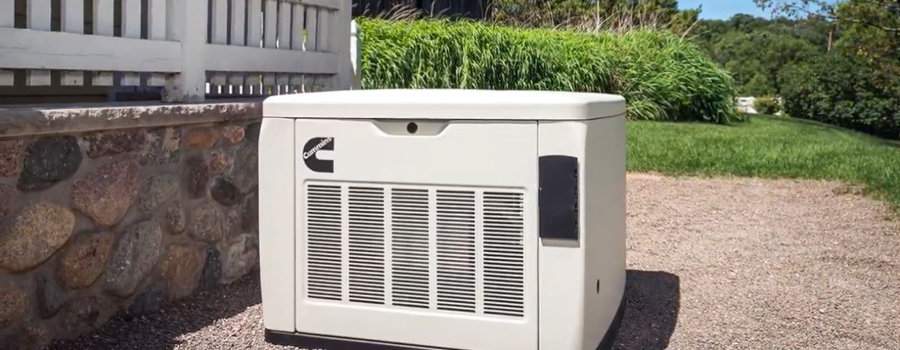Sizing Guide for Home Standby Generators

A whole house standby generator restores power seconds after a power outage or blackout strikes
Home Standby Generators were recently dubbed the "Next Must-Have Appliance" for the home. These technologically advanced machines protect homes and families by supplying power that keeps the lights on, the air conditioner or furnace running, and food in the refrigerator and freezer safe from spoilage. They power sump pumps, medical equipment, computers, lights, and kitchen appliances.
A power outage is detected the moment it happens and the generator automatically starts. After a few seconds to reach operating speed, the automatic transfer switch isolates the home from the utility and connects it to the generator which protects both your home and the utility from unexpected line hazards. In just seconds, power is restored and life goes on uninterrupted.
Standby Generator Backup Power Terminology
Choosing the right generator is important and the first question to answer, What Size Generator for the Whole House, is the first step to determining how much power you actually need. Too small a unit may not handle a central air conditioner and keep the pumps running that keep your basement dry. Using too large of a generator is inefficient and wastes fuel.
Generators are rated in watts or in kilowatts(kW). 1000 watts equals one kilowatt. Appliances are often rated in amps, amperes, volt-amperes or sometimes watts and kilowatts. Deciding which electrical circuits and appliances to power in an emergency is the first step to sizing a standby generator for your home.
Tip: Don’t let physical size fool you. A hair dryer can use 1200 to 1875 watts while an energy-saving LED light bulb might use as little as 6 watts (US DOE). Refrigerators use 750-950 Watts.
Standby Generator Buyer Guide: What Size Generator Do I Need?
Make Choices

Generac Guardian—Hands Down the Most Popular Home Standby Generator in America
Start by making a list of the most important circuits in your home. These include refrigerators and freezers, central air and furnace, sump pumps, well pumps, and medical equipment. Then start adding in the conveniences you don't want to lose. A television doesn't add very much power, nor does charging a cell phone charger or turning on a few lights. A microwave oven and crock pot or electric fry pan can cover most cooking needs.
Each item adds more power to the total capacity required. Supplying power to the entire home or almost the entire home is certainly an option, and in many cases is really the more cost efficient way to go. You still have to determine what you are likely to use during an outage and how much power it requires.
Check off your essentials, add in the conveniences, and then add a 15 to 25 percent margin for room to grow.
Most Popular Home Standby | Most Powerful NG Air Cooled | Consumer Reports Best Buy |
Choose a Generator for Critical Circuits Only
Determine Power Requirements

Cummins—The Worldwide Leader in Power Generation Products Like the Quiet Connect Home Standby Generator
For each item on the list, write down the power requirements in watts. Conversions between different methods of stating power are easy. Some items will list power as watts or possibly kilowatts, others will show the volts and amps used. Some may give the power as volt-amps. The goal is to determine the number of kilowatts required. For now, determine the number of watts each item requires.
Appliance Tag Power Conversions
| Label Stats | Find Watts |
|---|---|
| Volt-amps or VA | volt-amps = watts |
| Volts and amps given separately | volts x amps = watts |
| Kilowatts or kW | kilowatts x 1000 = watts |
| Watts | Watts ÷ 1000 = Kilowatts |
 Look at the items on your list that have electric motors and choose the one with the highest number of watts. Multiply that item's Watts x 3, and substitute the result for the original watts listed. This provides a necessary margin to ensure your generator will handle an additional load called Starting Watts of any motors. For example, a central air unit
Look at the items on your list that have electric motors and choose the one with the highest number of watts. Multiply that item's Watts x 3, and substitute the result for the original watts listed. This provides a necessary margin to ensure your generator will handle an additional load called Starting Watts of any motors. For example, a central air unit
Add up the Total Watts to determine how much power your home is likely to use during an outage. Divide the Total Watts by 1000 to find kilowatts.
Multiply kilowatts x 1.25 to add a margin of safety and for future power needs. This is the minimum Generator Capacity required for your home. For example, if you determine that your minimum Generator Capacity is 17.5 kilowatts, you'll want an 18-22 kilowatt generator to adequately power your home during an outage.
This sizing calculator can give you a general idea of the generator capacity you need.
Choose a Generator

When the Power Goes Out, A Home Standby Generator Restores Power in Less than a Minute
Avoid choosing the bare minimum. Power requirements just don't decrease for the vast majority of homeowners. A bigger freezer or refrigerator. A new, more powerful sump pump. Someone needs medical equipment. The new television for the rec room or den.
Norwall offers a wide array of air-cooled generators for most homes, and liquid-cooled models for larger homes and luxury estates.
Buyer Guide for Home Backup Generators
*These Sizing Guides are intended for estimating purposes only. Actual power requirements of high demand appliances vary widely by brand, model and capacity. Always have an authorized dealer or qualified electrician analyze your specific requirements before making a purchase decision.
Updated February 1, 2024
